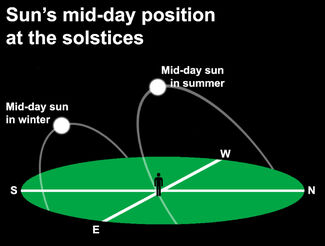A Change of Seasons
Last updated 1/6/2021 at 10:25am

Our lower wintertime temperatures occur mostly because our planet's axis is tipped 23.4 degrees to its orbit around our star, and the sun doesn't appear in our daytime sky very long.
Nights have been growing longer; snow is blanketing much of the land; and furnaces are working overtime. Yes, there's definitely a change of seasons coming our way.
It's surprising how many folks don't understand why the seasons even exist. Many believe that wintertime occurs because our planet lies farthest from the sun and we have lower temperatures as a result. Now, while it's true that our distance from the sun does change during the year, we're actually about 6 million miles closer to the sun during January than during July!
No, our lower wintertime temperatures occur mostly because our planet's axis is tipped 23.4 degrees to its orbit around our star, and the sun doesn't appear in our daytime sky very long.
During the months of December, January and February, the Earth's Northern Hemisphere tilts away from the sun, causing sunlight to hit us at a much shallower angle. Six months later – in summer – when we're on the opposite side of the sun, our planet's tilt aims the Northern Hemisphere toward the sun. Now Solar rays beat directly down onto the Northern Hemisphere.
Our sun's lower daily path at present means that it is only in our sky for about nine or so hours every day, not long enough to warm the air very much.
Why, then, isn't the year's coldest day on the first day of winter, when the sun appears to travel lowest in our sky? That's because our atmosphere takes time to respond to temperature changes. You know this intuitively; if you remove a pot of hot water from the stove, it won't cool instantly, and you make allowances for that when cooking.
Our atmosphere experiences the same phenomenon. The coldest time of the year in the Northern Hemisphere typically occurs not around the first day of winter but during late January or February.
The exact moment of the Northern Hemisphere's maximum tilt away from the sun – the time astronomers know as the winter solstice – occurs this year at 5:02 a.m. EST (2:02 a.m. PST) on Monday, Dec. 21. To sky watchers on Earth, this day marks the sun's lowest midday position in the sky and the beginning of its midday climb once again.
This marvelous moment has been celebrated by cultures throughout the ages as the rebirth of sunlight, warmth and life on Earth. It's not a coincidence that some of our world's major holidays are celebrated at this time of year. In fact, many – including Christmas – are scheduled around this one important astronomical event.
Even our term "solstice" originates in antiquity, coming from two Latin words "sol" (meaning "sun") and "sistere" (meaning "to stand still"). It is on the winter solstice that the sun's southerly midday drop seems to end, the sun "stands still" and our daytime star begins its ascendancy once again. From this moment on, the days become longer, and the sun gradually appears higher, and the greens of life slowly return to our planet's Northern Hemisphere.
Springtime, after all, is not that far away. And while the astronomer in me loves the long, dark nights of winter, I secretly await the increasing warmth of springtime!
Visit and follow Dennis Mammana at facebook.com/DennisMammana.



